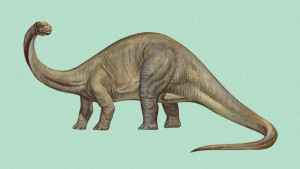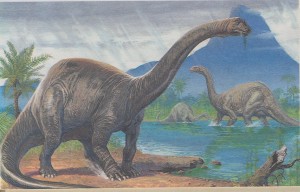Updated on: 04/04/2022
Brontosaurus is an extinct genus of sauropod dinosaurs that lived around 155 to 152 million years ago. This genus has long been considered as a synonym of Apatosaurus. In 1903, its type species Brontosaurus excelsus was reclassified as Apatosaurus excelsus. However, Brontosaurus’ ‘fake’ and ‘not real’ myths have been turned down following extensive research in 2015 that classified Brontosaurus as a distinct genus. It also recognized Brontosaurus parvus and Brontosaurus yahnahpin that once belonged to the genus Apatosaurus.
| Kingdom: | Animalia |
| Phylum: | Chordata |
| Clade: | Dinosauria |
| Order: | Saurischia |
| Suborder: | Sauropodomorpha |
| Family: | Diplodocidae |
| Subfamily: | Subfamily |
| Genus: | Brontosaurus |
| Type species: | Brontosaurus excelsus |
| Referred Species: | Brontosaurus parvus, Brontosaurus yahnahpin |
| Name Meaning: | Thunder lizard |
| Pronunciation: | bron-tuh-sawr-uh s |
| Geological Time Period: | Kimmeridgian era |
| Size: | Length – 70 – 85 ft (from head to tail) Height – 15 ft (at the hips) |
| Neck length: | 25 – 30 ft |
| Tail length: | 25 – 30 ft |
| Weight: | 15 tonnes (33069 lbs) |
| Range/Location: | North America |
| Diet: | Herbivore |
| Habitat: | Semiarid environment |
| Birth Type: | Eggs |
| Top speed: | 20–30 km (12–19 mi) per hour |
| Locomotion: | Quadrupedal |
Brontosaurus was a large animal with distinctive features like long, wide and deep neck; and large whip-like tail. Its skull remains have never been found, but scientists believe that it was similar to the skull of the Apatosaurus. It had chisel-like teeth only on the front of their jaws. Their neck vertebrae were deeply bifurcated. The dorsal ribs were slackly articulated. The caudal vertebra count varied, even within same species. Their neck was filled with air sacs. They had tall spines on its vertebrae. The forelimbs of this four-footed animal were a bit shorter than its hind limbs. They had claws on the first three toes of each foot. They had robust limb bones. Their arm bones were similar to that of the Camarasaurus.
It is believed that they were solitary and terrestrial animal. Some have argued that they were too heavy to carry their own weight on land all the time. Therefore, theoretically they should have stayed partly submerged in water. Diplodocid necks were not as flexible as it is generally depicted in films and documentaries. They could cover 20–40 km (12–25 mi) per day per day. It is believed that they were rarely attacked by predators present in its habitat. Even if they are attacked, they used their whip-like tail to defend itself. They had a long lifespan.
Brontosaurus type species Brontosaurus excelsus was named by Othniel Charles Marsh in 1879. Many specimens have been assigned to this species, including YPM 1980 (the holotype) and FMNH P25112 (mounted at the Field Museum of Natural History in Illinois, US). Both known B. excelsus fossil samples has been found in the Morrison Formation Brushy Basin in Albany County, Wyoming.

Brontosaurus parvus was first described as Elosaurus in the early 1900s. In 1994, it was reassigned to Apatosaurus and now it has been classified as belonging to Brontosaurus. B. parvus specimens include CM 566 (the holotype) and BYU 1252-18531 (discovered in Utah and now in display at the Brigham Young University) and UW 15556. B. yahnahpin, the oldest species, was unearthed from the Morrison Formation, Bertha Quarry in Wyoming.

In 1879, Marsh, then a professor of paleontology at the Yale University, introduced a new genre ‘Brontosaurus’ after the discovery of a large and almost complete sauropod skeleton from the Morrison Formation, Wyoming. In 1903, Elmer Riggs stated that ‘Brontosaurus’ did not have any striking difference that it could have its own genre and species. Therefore, he classified it as an Apatosaurus species calling it Apatosaurus excelsus. Most 20th century paleontologists agree that Riggs’ research was right. But in 1990, Robert T. Bakker argued that A. excelsus is distinct from A. ajax (Apatosaurus type species) and the former should have its own genus. Following a detailed research, published in 2015, Emanuel Tschopp, Octavio Mateus, and Roger Benson said that Apatosaurus and Brontosaurus were indeed distinct genera. They assigned B. excelsus as the type species of Brontosaurus; and classified A. parvus and A. yahnahpin to this ‘resurrected’ genus. Emanuel Tschopp said that their extensive research could not have been possible even fifteen years ago. It has happened because of the recent discoveries of several new dinosaurs similar to both Brontosaurus and Apatosaurus. And, it paved their way to undertake such detailed investigation.
The word Brontosaurus has come from Green words “brontē” meaning ‘Thunder’ and “sauros” meaning ‘Lizard.’